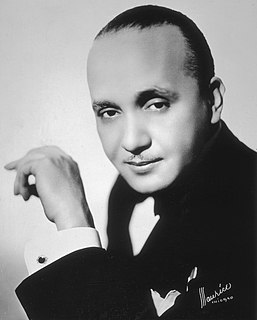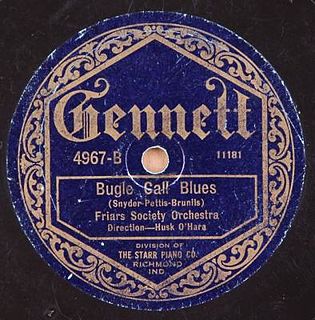Wellman Braud was an American jazz upright bassist. His family sometimes spelled their last name "Breaux", pronounced "Bro".

James Fletcher Hamilton Henderson was an American pianist, bandleader, arranger and composer, important in the development of big band jazz and swing music. He was one of the most prolific black musical arrangers and, along with Duke Ellington, is considered one of the most influential arrangers and bandleaders in jazz history. Henderson's influence was vast. He helped bridge the gap between the Dixieland and the swing eras. He was often known as "Smack" Henderson.

The New Orleans Rhythm Kings (NORK) were one of the most influential jazz bands of the early to mid-1920s. The band included New Orleans and Chicago musicians who helped shape Chicago jazz and influenced many younger jazz musicians.
Leon Joseph Roppolo was an American early jazz clarinetist, best known for his playing with the New Orleans Rhythm Kings. He also played saxophone and guitar.

Emmett Louis Hardy was an American jazz cornet player during the early 1900s.

George Clarence Brunies, a.k.a.Georg Brunis, was an American jazz trombonist, who was part of the dixieland revival. He was known as "The King of the Tailgate Trombone".

Joseph Gustaf "Sharkey" Bonano, also known as Sharkey Banana or Sharkey Bananas, was an American jazz trumpeter, band leader, and vocalist. His musical abilities were sometimes overlooked because of his love of being an entertainer; he would often sing silly lyrics in a high raspy voice and break into dance on stage.
Freddie Keppard was an American jazz cornetist who once held the title of "King" in the New Orleans jazz scene. This title was previously held by Buddy Bolden and succeeded by Joe Oliver.

Eugene Bertram Krupa was an American jazz drummer, bandleader and composer known for his energetic style and showmanship. His drum solo on Benny Goodman's 1937 recording of "Sing, Sing, Sing" elevated the role of the drummer from an accompanying line to an important solo voice in the band.
Frank Teschemacher was an American jazz clarinetist and alto-saxophonist, associated with the "Austin High" gang.

Ben Pollack was an American drummer and bandleader from the mid-1920s through the swing era. His eye for talent led him to employ musicians such as Benny Goodman, Jack Teagarden, Glenn Miller, Jimmy McPartland, and Harry James. This ability earned him the nickname the "Father of Swing".
Jabbo Smith, born as Cladys Smith was an American jazz musician, known for his virtuoso playing on the trumpet.

Benjamin "Bennie" Moten was an American jazz pianist and band leader born and raised in Kansas City, Missouri, United States.

Theodore Dudley "Red" Saunders was an American jazz drummer and bandleader. He also played vibraphone and timpani.
Leeds "Lee" Collins was an American jazz trumpeter.

"Bugle Call Rag", also known as "Bugle Call Blues", is a jazz standard written by Jack Pettis, Billy Meyers and Elmer Schoebel. It was first recorded by the New Orleans Rhythm Kings in 1922 as "Bugle Call Blues", although later renditions as well as the published sheet music and the song's copyright all used the title "Bugle Call Rag".

"Farewell Blues" is a 1922 jazz standard written by Paul Mares, Leon Roppolo and Elmer Schoebel.

The period from the end of the First World War until the start of the Depression in 1929 is known as the "Jazz Age". Jazz had become popular music in America, although older generations considered the music immoral and threatening to cultural values. Dances such as the Charleston and the Black Bottom were very popular during the period, and jazz bands typically consisted of seven to twelve musicians. Important orchestras in New York were led by Fletcher Henderson, Paul Whiteman and Duke Ellington. Many New Orleans jazzmen had moved to Chicago during the late 1910s in search of employment; among others, the New Orleans Rhythm Kings, King Oliver's Creole Jazz Band and Jelly Roll Morton recorded in the city. However, Chicago's importance as a center of jazz music started to diminish toward the end of the 1920s in favor of New York.
Walter Melrose was a music publisher and lyricist in the 1920s and 1930s.











